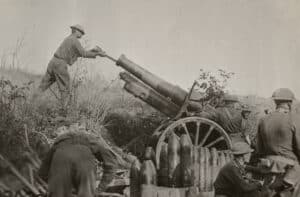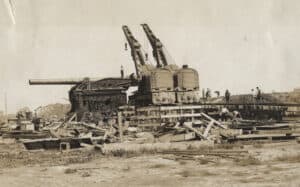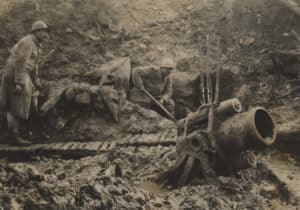A 9.25 inch (23.5 cm) by 3 inch (7.62 cm) rusted shell.
World War I was a war of artillery—The Big Guns. Rolling barrages destroyed the earth of France and Belgium and the lives of many. Millions of shells were fired in single battles, with one million shells alone fired by the Germans at the French Army in the first day at the 1916 battle of Verdun, France.
Different types of weapons made up the artillery of WWI. Guns had a long barrel and shot almost directly at their target. Howitzers had a shorter barrel and a fired their projectiles in a curved trajectory. Mortars had a short barrel, a higher curved trajectory and were mainly placed in trenches.
60% of the battlefield casualties in WWI were caused by artillery shells exploding. Shrapnel wounds were particularly brutal for soldiers. The word ‘shrapnel’ comes from the small lead balls placed in an artillery shell that would spread out over the battlefield when exploded. It was named for English officer Henry Shrapnel, who invented the design in the late 18th century.
Artillery was more destructive than ever before. The largest bore of an artillery piece in WWI (‘bore’ meaning the diameter of the barrel or tube) was on the French 520 mm. (French artillery was always pointed toward Germany—even in practice.) The Big Bertha was a German 420 mm howitzer, named for a family member of the Krupp Arms manufacturer. A shell hole left by a 15 cm ‘Jack Johnson’ (a German howitzer named after the famous boxer Jack Johnson because of its ‘punch’) had a diameter of 28 feet (8.53 m) across and roughly 6 feet (1.83 m) deep in the centre.
Soldiers under fire could identify artillery by specific noises they made: One combatant noted that the French 75 mm gun had a “sharp, decisive note … which speaks quickly and in anger.” Soldiers also spoke of the “peculiar crack, crack they make.” The German 105 mm howitzer was called a whizzbang. British soldiers said, “If you happened to be near the receiving end, you first heard the thing burst, then the whiz of its approach and lastly the boom of the gun that fired it.”




